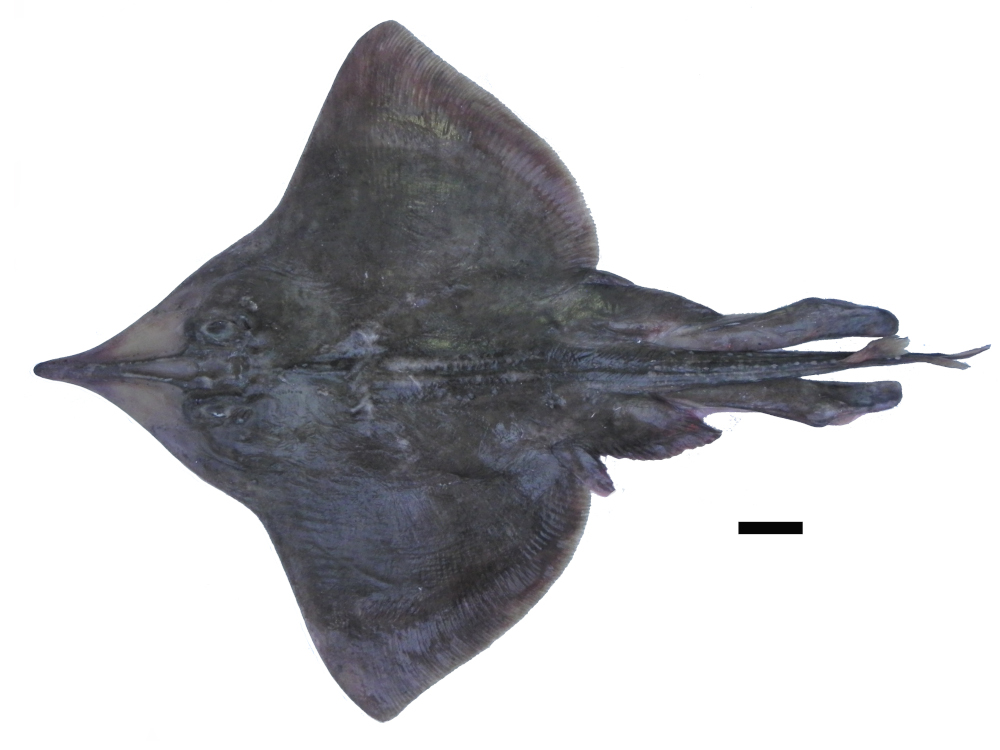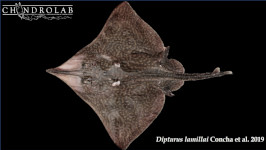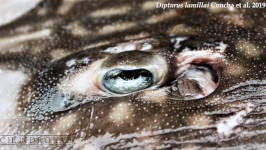Zearaja brevicaudata
(Marini, 1933)
Yellownose skate
Classification: Elasmobranchii Rajiformes Rajidae
Reference of the original description
Rectificando errores ictiólogicos. Physis, 11(39), 328–332
Rectificando errores ictiólogicos. Physis, 11(39), 328–332
Synonyms / new combinations and misspellings
Dipturus brevicaudata, Dipturus lamillai, Raia brevicaudata, Raja brevicaudata
Dipturus brevicaudata, Dipturus lamillai, Raia brevicaudata, Raja brevicaudata
Types
Zearaja brevicaudata
Dipturus lamillai
Holotype: MNHNCL: ICT 7531; Paratype: CAS: 242403; MNHNCL: ICT 7532;
Raia brevicaudata
Holotype: MACN: Ict-569;
Zearaja brevicaudata
Dipturus lamillai
Holotype: MNHNCL: ICT 7531; Paratype: CAS: 242403; MNHNCL: ICT 7532;
Raia brevicaudata
Holotype: MACN: Ict-569;
Description :
Citation: Zearaja brevicaudata (Marini, 1933): In: Database of modern sharks, rays and chimaeras, www.shark-references.com, World Wide Web electronic publication, Version 12/2025
Please send your images of "Zearaja brevicaudata" to info@shark-references.com

Zearaja brevicaudata (Marini, 1933) mature male © Valeria Gabbanelli, Instituto de Investigaciones Marinas y Costeras (IIMyC)-CONICET

Zearaja brevicaudata (Marini, 1933) mature male © Valeria Gabbanelli, Instituto de Investigaciones Marinas y Costeras (IIMyC)-CONICET
Common names
 Raya hocicuda de cola corta,
Raya hocicuda de cola corta,  short tail Yellownose skate
short tail Yellownose skate
 Raya hocicuda de cola corta,
Raya hocicuda de cola corta,  short tail Yellownose skate
short tail Yellownose skate
Short Description
Diagnose after GABBANELLI, DE ASTARLOA, GONZALEZ-CASTRO, VAZQUEZ & MABRAGANA, 2018 [26826]: Zearaja brevicaudata is a relatively large species of skate with a rhombic-shaped disc characterized by the combi-nation of the following characters: relatively large snout (1.7–2.9 times tail length), short tail (2.1–2.7 times in total length), and short distance between the first gill openings (3.42–4.19 times indirect disc length). Even though these relationships overlap with those of Z. chilensis, these features differ diagnostically among specimens of similar size (Fig. 7). The dermal denticles are mainly restricted to the rostral area, both in dorsal and ventral surfaces. Denticles are more conspicuous in adults, and can be absent or in less number in neonates and juveniles. Three to five rows of thorns are present on the tail (rarely only one). The clasper is relatively long and stout, 74–78% of the tail’s length in adult specimens. The terminal bridge (Tb) is straight towards the tip of dorsal terminal 2, and the spike is thin and does not reach the Tb. The ventral terminal cartilage has a short apophysis, and its outer edge is narrow. The distal tip of the axial is relatively narrow.
Diagnose after GABBANELLI, DE ASTARLOA, GONZALEZ-CASTRO, VAZQUEZ & MABRAGANA, 2018 [26826]: Zearaja brevicaudata is a relatively large species of skate with a rhombic-shaped disc characterized by the combi-nation of the following characters: relatively large snout (1.7–2.9 times tail length), short tail (2.1–2.7 times in total length), and short distance between the first gill openings (3.42–4.19 times indirect disc length). Even though these relationships overlap with those of Z. chilensis, these features differ diagnostically among specimens of similar size (Fig. 7). The dermal denticles are mainly restricted to the rostral area, both in dorsal and ventral surfaces. Denticles are more conspicuous in adults, and can be absent or in less number in neonates and juveniles. Three to five rows of thorns are present on the tail (rarely only one). The clasper is relatively long and stout, 74–78% of the tail’s length in adult specimens. The terminal bridge (Tb) is straight towards the tip of dorsal terminal 2, and the spike is thin and does not reach the Tb. The ventral terminal cartilage has a short apophysis, and its outer edge is narrow. The distal tip of the axial is relatively narrow.
Distribution
Endemic of the Southwestern Atlantic, from southern Brazil to at least the Beagle Channel [26826] Source: www.gbif.org
Endemic of the Southwestern Atlantic, from southern Brazil to at least the Beagle Channel [26826] Source: www.gbif.org
Remarks
shark-references Species-ID=15264
shark-references Species-ID=15264
Parasites (arranged by Jürgen Pollerspöck)
Myxosporea
Monogenea
Cestoda
Trematoda
Nematoda
Copepoda
Myxosporea
- Chloromyxum zearaji Cantatore, Irigoitia,Holzer, Bartosova-Sojkova, Peckova, Fiala & Timi, 2018 [31017]
Monogenea
- Acanthocotyle sp. [31017]
- Dendromonocotyle rajidicola Irigoitia, Chisholm & Timi, 2016 [31017]
- Merizocotyle euzeti Irigoitia, Cantatore, Delpiani, Incorvaia, Lanfranchi & Timi, 2014 [31017]
- Rajonchocotyle emarginata (Olsson, 1876) [31017]
Cestoda
- Acanthobothrium domingae Franzese & Ivanov, 2020 [28777] [31017] [31906]
- Echeneibothrium multiloculatum Carvajal & Dailey, 1975 [30919] [31906] [31742]
- Echeneibothrium sp. [31017]
- Echeneibothrium williamsi Carvajal & Dailey, 1975 [30919] [31906] [31742]
- Grillotia (Grillotia) patagonica Menoret & Ivanov, 2012 [31017]
- Heteronybelinia sp. [31017]
- Phyllobothrium sp. [31017]
Trematoda
- Otodistomum sp. [31017]
Nematoda
- Anisakis simplex (Rudolphi, 1809) [31017]
- Contracaecum sp. [31017]
- Phocanema cattani (George-Nascimento & Urrutia, 2000) Bao, Giulietti, Levsen & Karlsbakk, 2023 [31017]
- Piscicapillaria sp. [31017]
- Proleptus acutus Dujardin, 1845 [31017]
- Pseudanisakis argentinensis Irigoitia, Braicovich, Farber & Timi, 2017 [31017]
Copepoda
- Eudactylina parva Castro-Romero & Baeza-Kuroki, 1991 [31017]
- Schistobrachia ramosa (Krøyer, 1863) [31017]


















